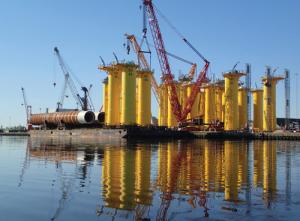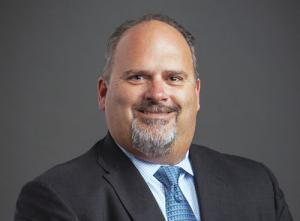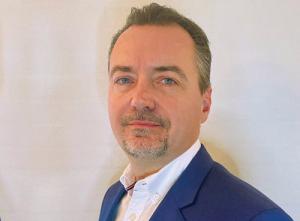Burns & McDonnell and Bladt Industries
J. Brett Williams is President, NEO at Burns & McDonnell.
Bo Moerup is Chief Commercial Officer at Bladt Industries A/S.
The offshore wind revolution is coming to America. It makes sense as the wind at sea blows stronger and more consistently than the wind on land. Ask any sailor. PUF didn't use that excuse to go offshore sailing, instead finding experts from two continents who are brought together in a quest to capture the wind as part of the decarbonization revolution.

Here, we bring you Bladt Industries from Denmark, which specializes in building steel structures, and is a pioneer on the foundation side for offshore wind turbines. Bladt has entered an exciting partnership with the more familiar Burns & McDonnell to capture those winds offshore America especially taking aim at the Eastern Seaboard.
PUF talks here with Brett Williams of Burns & McDonnell and Bo Moerup of Bladt Industries about what it takes to build these massive structures far out in deep waters. Not an easy task.
PUF's Steve Mitnick: What's this big announcement and what are we going to see happen in the coming years?
Brett Williams: This announcement is exciting. It's leveraging the strengths of two established companies to execute work along the Eastern Seaboard in an industry that hasn't yet arrived in the U.S.
 Brett Williams: It begins offshore with these offshore substations, but there’s a tremendous amount of work onshore to beef the grid up to handle the loads that are being generated.
Brett Williams: It begins offshore with these offshore substations, but there’s a tremendous amount of work onshore to beef the grid up to handle the loads that are being generated.
With Bladt Industries, they are a world leader in fabricating offshore wind foundations, substations, and items of that manner. They've executed projects in a lot of countries, but none in the U.S., because it simply hasn't been built here.
Conversely, Burns & McDonnell is over a hundred years old. We've built nearly every kind of infrastructure in this country that you can imagine, except offshore wind. We're taking the engineering, construction, fabrication side of Burns & McDonnell, and combining it with the horsepower of Bladt Industries that has all the experience in this industry.
We've formed a partnership to deliver a portion of the work for this offshore wind industry to our clients that's very cost effective. With it, they get the best of both worlds. We certainly know how to execute work in the U.S. We've been doing it for many years. Bladt has the industry experience that nobody can touch on their end. It's exciting for both companies.
PUF: Bo, your company has been building offshore wind in Europe. Talk about your company and all these facilities.
 Bo Moerup: You can build massive wind farms. You can do it faster than nuclear, including planning.
Bo Moerup: You can build massive wind farms. You can do it faster than nuclear, including planning.
Bo Moerup: Bladt Industries has more than sixty years' experience in steel structures in general, and now more than twenty years in offshore wind. It's been one of the pioneers in doing the foundation side for offshore wind turbines.
Just like onshore wind did over the last decades, offshore wind is now also spreading. It started in Northern Europe, and it's expanding through Europe and now going to Asia and to the U.S.
We want to follow that trend and seek opportunities also on the Eastern Seaboard. We're excited that we've been able to make this alliance. We look forward to getting this off the ground, now that the U.S. offshore market, as Brett alludes to, is finally taking off. I've been twenty-five years in wind. My first experience with offshore wind was 2004, in Vestas Offshore Wind.
Back then, maybe 2005 or 2006, I had the first meetings and discussions on the Cape Cod Project, which is now no longer an active project. Already back then, we were expecting the U.S. offshore to start taking off. We've been waiting for quite a period. Now at last, it finally seems that it's ready to take off.
 The 2016 Nordsee One Installation is an example of an offshore substation. Source: Bladt Industries A/S
The 2016 Nordsee One Installation is an example of an offshore substation. Source: Bladt Industries A/S
PUF: Both you and Brett use the term, foundations. You're going to put up these massive giant turbines in the ocean. That's important but difficult.
Bo Moerup: Yes. For onshore wind, basically, you make a concrete slab, then install the turbine tower on that.
Whereas, when you go offshore, there are different numbers of designs, but the most predominant design is a monopile. It's a steel tube, but a massive one. It's hundreds of feet long, and hundreds of metric tons in weight. These are massive constructions.
PUF: It seems like one of the big constraints is because all the manufacturing is done over in Europe. How do you get the foundations here? Is the idea to be able to build a lot of it in the U.S. in order to accelerate things?
Brett Williams: Yes. Since it's a fairly new industry we're not tooled up just yet in this country, at the skill level we need to be to manufacture these types of foundations. We're going to rely on importing major components from Europe by utilizing Bladt. However, there is a big push for local spend, and involvement.
The assembly of these components, and what I call light fabrication, will have to be fabricated on site at the ports. That will be a joint effort between Bladt and Burns & McDonnell. From there, we load it onto a barge, and then it gets shipped off for installation.
PUF: This could become a big industrial base in the U.S. It could create a lot of jobs. Is that a possibility?
Brett Williams: Yes. The overall offshore wind effort will create thousands of jobs. We are looking at components of offshore wind on our end, but then you also factor in the contractors that will install it.
Then you have to install subsea cable, bring it onshore, plug it into the electric grid, and in a lot of cases, upgrade the electric grid to handle all the electrons that will be pumping through it. That's a tremendous, completely separate effort.
PUF: Bo, paint a picture of what you have to do. What kind of factories are there? What kind of metals or other equipment are you fabricating over there? Maybe we're going to do some of that here.
Bo Moerup: Bladt is involved in what you might call three of the major components in an offshore wind farm. The biggest or most complex maybe is the offshore substations. When you build massive offshore installations, you would often do the substation offshore in order to minimize electrical losses. That's one aspect. We have a couple of orders already in the U.S. that we'll be executing the next couple of years.
What we'll be doing together with Burns & McDonnell is what's called secondary steel. The way you do these foundations, is a monopile, which is just rolled steel. It is not rocket science, but it requires massive equipment, because they are very long and heavy plates. Those thick plates, like three to four inches of plates, are difficult to roll. It requires specialized equipment.
Then you have the monopile, which you hammer with a hydraulic hammer on a floating vessel. You hammer that into the seabed. Now, because you hammer it into the seabed, it also means you cannot have all sorts of fixtures on it. Whether you bolt them or weld them or whatever you do, they would come off because of the forces.
What you do with today's technology is, you put a transition piece on top of it. You have this piece of steel that you hammer into the seabed, but then you get the smart bit of steel, the transition piece. This is transitioned between the monopile and the tower that you then install on top.
This is what we'll be doing in the alliance with Burns & McDonnell in the U.S. Again, you have a steel monopile, but this is where you add all the secondary steel. That is boat landings, anodes to protect against corrosion, and platforms. It's also a lot of internal items, depending on the specific design of such a transition piece. That's what we'll be doing. We'll be doing the smarter part of the foundations.
PUF: You have to have an offshore substation. You are experts in electrical engineering and do a lot of work at substations. What's an offshore substation going to be like?
Brett Williams: They are massive structures. That particular scope of work is outside of the scope of both companies in our latest agreement. We are onboarding an offshore substation engineering manager in Europe that will mentor and train our U.S. staff and hire new electrical engineers to design these substations. Essentially, it's collecting all the electricity that's being generated, coming off the turbines, into a single central location.
It makes it efficient when the substations are out near the turbines. You have to build them offshore. From there, you do a subsea cable, and then you bring it from the wet conditions onto the dry ones to an interconnection onto the grid.
As it stands, in a lot of cases the grid is not equipped to handle the amount of power that's going to be generated coming out of these stations. It begins offshore with these offshore substations, but there's a tremendous amount of work onshore as well to beef the grid up to handle the loads that are being generated.
PUF: If we build one of these big offshore wind farms, is it that much power you have, that it's a major challenge as far as the interconnection with the existing onshore grid?
Brett Williams: In many cases, yes. It's not on the scale of a thousand-megawatt nuclear plant per se, depending on where you are and which local utility you're working with, some are equipped to handle it better than others. The electric grid as it stands now was not designed with offshore wind in mind.
For the past fifteen or twenty years in this country, we've been working hard to upgrade the electric grid overall. The industry's made great strides, but it's still lacking. There's a tremendous amount of work that needs to be done, to make offshore wind farms operational.
PUF: In some cases, in the Midwest, they are getting to capacity factors over fifty percent. Could these offshore wind farms in the Atlantic have higher capacity factors?
Bo Moerup: You wouldn't go much above fifty. The ones you mentioned onshore with capacity factors of fifty are few and far between. Onshore capacity factors on good sites are thirty, thirty-five percent or so. Offshore, we are looking at normally between forty-five, fifty, or fifty-two percent or so in capacity factors, which is brilliant for wind and way above onshore.
That is one of the reasons we are doing offshore. First of all, you can get your pick of turbines out there. With the bigger turbines the manufacturers are doing today, with ten, twelve, fourteen megawatts, it's basically impossible to even transport them onshore. Plus, it's difficult to find places where you can install maybe a hundred of them together in a one-gigawatt (or one thousand megawatt) wind farm.
But offshore, you can. You have different restrictions or challenges logistically, but it's possible to do. That's what drives the offshore. You can build massive wind farms. You can do it much faster than nuclear, including planning and everything. It's easily five, eight years quicker than building a comparable size nuclear plant.
PUF: Give me an optimistic picture. How big can this be in the next five to ten years in the Atlantic off the east coast? Can it make an impact on the addition of non-carbon emitting generation in the eastern U.S.?
Bo Moerup: Definitely. I would almost say the sky's the limit. The potential is there in wind energy, so the energy that's available there is massive. With three hundred and thirty million people, the demand for electricity is massive and there's no one to say you shouldn't be able to also explore exporting electricity north to Canada or south to Mexico. Why not?
You have a massive potential there to do this. It's a matter of building a sustainable market, meaning that companies like ours and others, and of course also the developers behind this, can see that there is a sustainable market.
It must not be a stop-and-go market, if we are to make the investments locally. That goes both for the American and the European companies. We can make these investments only if we see that year after year, there will be gigawatts to install. That's what will drive what you might call the localization of this and drive local job creation.
Brett Williams: I agree a hundred percent with Bo. We can take it as far as we want. We have enough capacity, and the right conditions offshore to generate up to four times as much power as this country needs. We're not going to do that, but the conditions are there.
It's now a real industry. It's finally arrived. The door is going to open for us to get these things permitted and get them under construction. What it means for Burns & McDonnell is sustained growth over the next several years.
When I say we're going to invest, we already have, but we're going to invest substantially more into this market. On the very low end, along the East Coast anyway, with our operations, we're looking at probably twenty, twenty-five, or thirty percent growth year over year for several years. At some point, it will plateau, but that's far enough out that we haven't even attempted to figure out what or when that is.
We're excited about it. Again, it's having the right partnership going into this and being competitive. Once you build the first round of these offshore wind farms and are successful, then it becomes a repeatable model that improves over time. That is certainly our goal.
Lead image: The 2016 Sandbank is an example of an offshore foundation. Source: Bladt Industries A/S



